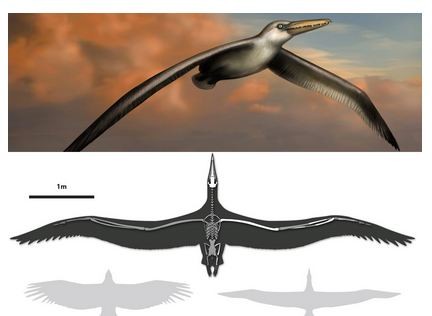Scientists Discover Largest Prehistoric Flying Bird
| Arthur Dominic Villasanta | | Jul 08, 2014 05:51 AM EDT |
A fantastic prehistoric bird that shouldn't have been able to fly because of its huge size has finally received scientific recognition as the largest flying bird yet discovered.
The long-extinct bird called "Pelagornis sandersi" took to the skies during the Miocene Epoch from 23 million to 5 million years ago. It soared aloft on gigantic wings with a span of 21-feet or over six meters from wingtip to wingtip that allowed it to hunt fish with its toothed beak.
Like Us on Facebook
Pelagornis is a genus of prehistoric "pseudotooth birds" that are probably close relatives of today's pelicans and storks.
Scientists said the extinct avian is an aerodynamic anomaly because Pelagornis sandersi's huge size means it shouldn't have been able to fly at all. A bird as large as Pelagornis would have placed too massive a strain on its muscles to keep it in flight, and this ability was thought improbable until the discovery of Pelagornis.
The only known fossilized wings of a Pelagornis sandersi had a wingspan of 6.4 meters. This is far longer than that of the Royal Albatross, which counts among the largest living flying birds today. This albatross has a wingspan of over three meters.
Because of its size, Pelagornis sandersi would probably have has a difficult time getting off the ground. Scientists said the bird would probably have had to run downhill to generate the velocity needed for it to take-off.
As it was a fish-eating bird, Pelagornis sandersi would most likely have taken-off from cliffs near the sea and soared heavenwards on strong sea winds.
Its large wings, however, allowed Pelagornis sandersi to fly immense distances over ocean waters in search of its prey, normally fish swimming near the surface.
The only known skeleton of the bird was discovered in 1983 in South Carolina. Its first formal description was released only this July 7 by the Proceedings of the National Academy of Sciences.
The bird is named after Albert Sanders, a retired curator who collected the bird's fossil after it was discovered.
Tagslargest prehistoric bird, discovery, Pelagornis Sandersi, Albert Sanders
©2015 Chinatopix All rights reserved. Do not reproduce without permission
EDITOR'S PICKS
-

Did the Trump administration just announce plans for a trade war with ‘hostile’ China and Russia?
-

US Senate passes Taiwan travel bill slammed by China
-

As Yan Sihong’s family grieves, here are other Chinese students who went missing abroad. Some have never been found
-

Beijing blasts Western critics who ‘smear China’ with the term sharp power
-

China Envoy Seeks to Defuse Tensions With U.S. as a Trade War Brews
-

Singapore's Deputy PM Provides Bitcoin Vote of Confidence Amid China's Blanket Bans
-

China warns investors over risks in overseas virtual currency trading
-

Chinese government most trustworthy: survey
-

Kashima Antlers On Course For Back-To-Back Titles
MOST POPULAR
LATEST NEWS
Zhou Yongkang: China's Former Security Chief Sentenced to Life in Prison

China's former Chief of the Ministry of Public Security, Zhou Yongkang, has been given a life sentence after he was found guilty of abusing his office, bribery and deliberately ... Full Article
TRENDING STORY

China Pork Prices Expected to Stabilize As The Supplies Recover

Elephone P9000 Smartphone is now on Sale on Amazon India

There's a Big Chance Cliffhangers Won't Still Be Resolved When Grey's Anatomy Season 13 Returns

Supreme Court Ruled on Samsung vs Apple Dispute for Patent Infringement

Microsoft Surface Pro 5 Rumors and Release Date: What is the Latest?










